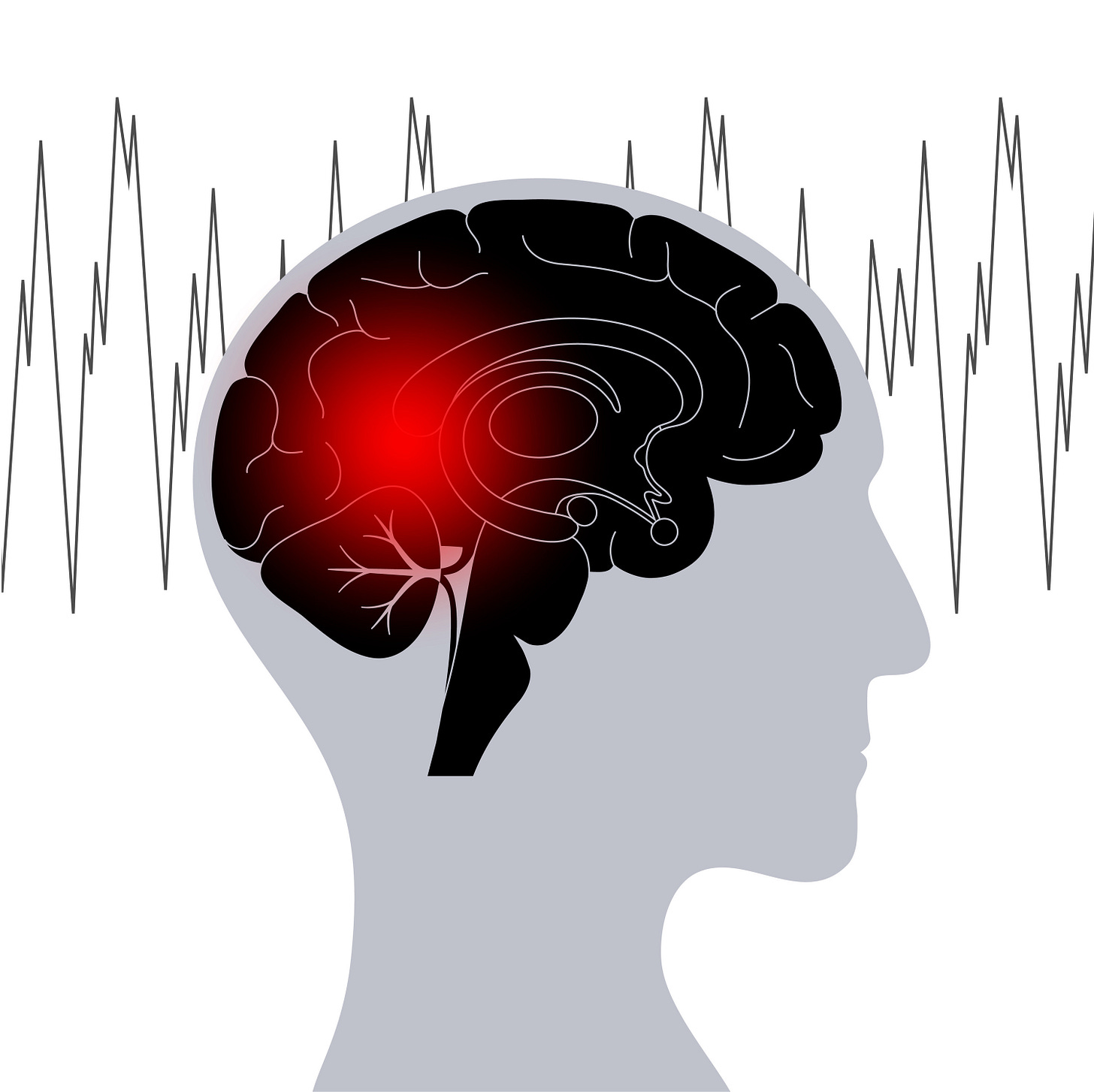Case study
How common are seizures in MS? I developed seizures about a year after diagnosis.
Prof G’s opinion
Seizures and epilepsy (recurrent seizures) are relatively common in people with MS.
The reason why MS causes seizures is that MS is also a grey matter disease and involves the cortex or surface of the brain. MS lesions in the cortex are thought to irritate nerve cells to fire spontaneously, which results in seizures. When these seizures are recurrent, the person, by definition, has epilepsy (recurrent unprovoked seizures).
The superficial grey matter on the surface of the brain is made up of the cell bodies of neurones; many diseases of grey matter cause seizures, including MS.
The study below shows that 4.6% of pwMS have seizures, strongly associated with MRI lesions abutting the grey matter. These lesions are often called subcortical lesions, but with newer MRI techniques, they can be shown to extend into and involve the cortex. The incidence of epilepsy depends on disease duration and is closer to 10% in the more advanced or progressive phase of MS. Please note as the study below is cross-sectional, many subjects in this study are yet to develop epilepsy, which is why the lifetime prevalence of epilepsy will be higher than 4.6%.
It is essential that if you have MS and develop epilepsy, it is not assumed to be due to MS and that you are reinvestigated to exclude other causes, such as tumours and infections. I have looked after several pwMS with comorbid brain tumours, such as meningiomas, gliomas, lymphomas and metastases from peripheral cancers. I have also seen numerous patients who present with seizures and are then found to have MS.
Seizures can also be a manifestation of new focal inflammatory disease activity, i.e. new lesions involving the cortex. New onset epilepsy can be considered a relapse, particularly when associated with new lesions on MRI or a raised neurofilament level.
If you are on an immunosuppressive DMT, you also need to consider whether or not a seizure is not a manifestation of an infection or encephalitis, for example, herpes encephalitis. In the case of natalizumab (Tysabri) and other immunosuppressive DMTs, this could be the first manifestation of PML.
Epilepsy in pwMS tends to be focal epilepsy with or without secondary generalisation. The symptoms of focal epilepsy depend on what part of the cortex is involved, and these then give you the characteristic aura before the seizure activity spreads to the rest of the brain. Focal epilepsy, or the aura, is classified as a simple seizure if your consciousness does not change. In comparison, complex partial seizures (CPS) alter consciousness. CPS tend to localise to the frontal or temporal lobes of the brain.
Generalised seizures are classified by what happens during the seizure and are referred to as absence, tonic, clonic, tonic-clonic or atonic. Absence seizures, sometimes called petit mal seizures, can cause rapid blinking or a few seconds of staring into space. With tonic seizures, the body goes into a spasm. This can be followed by jerking of the whole body, which is the clonic phase. Hence the term tonic-clonic seizures. A rare form of generalised seizure is an atonic seizure, where the body loses tone; this form of seizure is associated with sudden falls during which the patient can sustain injuries.
In my experience, epilepsy in MS responds to typical anticonvulsant drugs. The problem with all anticonvulsants is that they are sedative and may worsen cognitive impairment. In general, anticonvulsants are poorly tolerated by pwMS. Anticonvulsants could also interact with your other drugs and must be considered carefully. For example, if you are a young woman on the oral contraceptive pill, you must take an anticonvulsant that doesn’t interact with the pill; otherwise, you may have an unwanted pregnancy.
The biggest problem for pwMS is that if you have a seizure, it is assumed that you are at risk of recurrence, i.e. they are unprovoked and are due to your MS. If this is the case, then you can’t drive until you have been seizure-free for a period of time (e.g. 12 months in England). The exact duration of a driving ban depends on which country you live in. Other information you need about seizures is that they can cause sudden death (SUDEP = sudden unexplained death in epilepsy), accidents and drownings. Therefore, your neurology team should warn you about these things and advise you on how to prevent them from occurring. If you do have epilepsy, there is a chance of provoking your seizures by fasting, sleep deprivation or alcohol. The general rules for people with epilepsy apply to pwMS who have seizures.
A seizure can be terrifying, and being at risk of further seizures results in anxiety. The risk of developing seizures increases with MS disease duration and typically occurs in pwMS with advanced MS in the so-called progressive disease. Therefore, if we can prevent MS from worsening, we should prevent most seizures.
Seizures and epilepsy are part of the burden of MS. They are, therefore, another reason for early effective treatment and the suppression of all disease activity, i.e. the so-called treat-2-target of NEIDA (no evident inflammatory disease activity) to prevent new lesions developing and affecting the cortex to cause MS.
The following is some general safety advice for people with epilepsy
Medication adherence: Please take your prescribed anti-convulsant or anti-seizure medication as directed.
Lifestyle adjustments: Please ensure you get enough sleep, eat balanced meals, and manage stress as well as possible. Lack of sleep, poor nutrition, and stress can trigger seizures in some individuals.
Safety at home: Make your living environment safe by minimising potential hazards. Ensure that your living space is well-lit, keep walkways clear of clutter, and if you are disabled, consider installing handrails in bathrooms and staircases to prevent falls during a seizure.
Bathroom safety: When taking a bath or shower, it is advisable to have someone nearby or use a shower chair to reduce the risk of drowning during a seizure. Don’t run the hot bathwater first, or install a thermostatic mixing valve to regulate water temperature.
Water activities: Swimming alone is not recommended for individuals with epilepsy, especially in deep water or open areas. Always swim with a buddy or under the supervision of a lifeguard.
Cooking safety: Be cautious when cooking to avoid burns or accidents during a seizure. Use oven mitts, avoid cooking with open flames, and consider using kitchen appliances with automatic shut-off features.
Driving restrictions: It is essential to consult your HCP and follow local driving regulations. In some countries, individuals with epilepsy must be seizure-free for a specific period before being allowed to drive; in England, it is 12 months. Adhering to these restrictions ensures the safety of the person with epilepsy and others on the road.
Communicate with others: Inform family members, friends, and coworkers about your condition and what to do in case of a seizure. Educating those around you about epilepsy can help create a supportive environment and reduce anxiety for everyone involved.
Emergency preparedness: Carry identification stating your condition, emergency contact information, and necessary medical details. In case of a seizure, this information can assist first responders in providing appropriate care—for example, a MedicAlert bracelet or neckless tag.
I am interested to learn from you. How many of you have had seizures as a first manifestation of MS, later in the course of the disease, as new disease activity, etc.? How was your seizure/epilepsy investigated, and how have you done on treatment?
Background: Seizures in people with multiple sclerosis (MS) are reported; however, the risk of epilepsy in adults with MS remains poorly defined.
Methods: We performed a systematic review and meta-analysis to evaluate the incidence and prevalence of epilepsy in adults (≥ 18 years) with MS compared to those without. We searched MEDLINE and EMBASE from inception to July 1, 2022 to include observational studies that reported the prevalence or incidence of epilepsy in adults with MS and a comparator group, consisting of adults without MS or the general population. We used the Newcastle Ottawa Scale to evaluate quality of the included studies. We performed random-effects meta-analyses to determine the prevalence and incidence of epilepsy in adults with MS compared to the non-MS group.
Results: We identified 17 studies consisting of 192,850 adults with MS, across nine countries. Most studies were of moderate quality as they did not specify the MS type or type of seizures. Compared to a comparison group, both the prevalence (pooled OR 2.04; 95% confidence interval 1.59-2.63, I2 = 95.4, n = 12) and the incidence of epilepsy (pooled RR 3.34; 3.17-3.52, I2 = 4.6%, n = 6) was higher in people with MS. Heterogeneity in estimates was not explained by additional analyses.
Conclusions: MS is an independent risk factor for both incident and prevalent epilepsy, suggesting variation in grey matter involvement over the disease course. Longitudinal studies are required to help identify patient and disease characteristics associated with epilepsy.
Subscriptions and donations
Paid subscriptions to MS-Selfie are being used to administer the Newsletter and associated MS-Selfie microsite, which is now open to all readers. At the request of several readers, I have now added the option of making a one-off donation. Because of the falloff in paying subscribers, I have reinstalled the paywall, which allows paying subscribers access to a weekly Q&A newsletter. The Q&A session covers topics I don’t cover in the regular MS-Selfie Newsletters.
General Disclaimer: Please note that the opinions expressed here are those of Professor Giovannoni and do not necessarily reflect the positions of Barts and The London School of Medicine and Dentistry nor Barts Health NHS Trust. The advice is intended as general and should not be interpreted as personal clinical advice. If you have problems, please tell your own healthcare professional, who will be able to help you.














Share this post